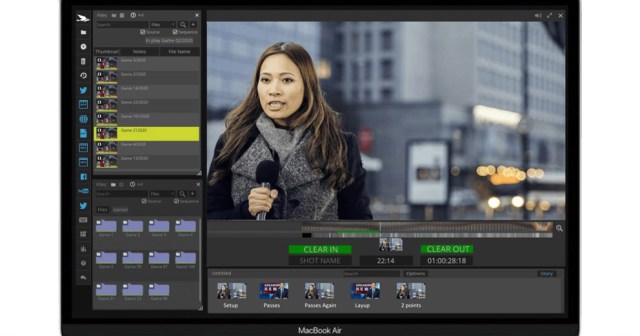
How can media technology companies move workflows to the cloud, while driving efficiencies? How is business agility changing in live production, and what is the impact of 5G and edge computing? How do media producers deal with AI and exponential change in technology, while also focusing on lower carbon emissions from production?
To tackle these issues, cloud-native video editing company Blackbird hosted a panel session titled “A View From the Top: Media Tech’s Hottest Topics Discussed.” The panel comprised Jeremy Dujardin, CTO M&E, Tata Communications; John Honeycutt, Founder, Sandy Valley Media, Director, Blackbird, and former Google, Discovery and Fox tech leader; Session Host David Shapton, Founder, Future Transform; and James Stellpflug, SVP Markets, EVS.
Honeycutt, who joined the Blackbird board as a Non-Executive Director last year, was SVP Broadcast Operations at Fox from 1995 until to 2003 before holding roles as Chief Media Technology Officer, Chief Operating Officer as well as Chief Technology Officer at Discovery from 2003 to 2019. Honeycutt then joined Google as Vice President of Telecommunications, Media and Entertainment and Gaming, where he developed Google Cloud’s initial product development and go-to-market strategies across those sectors globally.
“I’ve said for a long time that this is an evolution not a revolution. In some ways all this new technology is quite revolutionary, but as content owners, creators and distributors, our job is to figure out how to harness it. And I think that’s what we’re going through now, finding out the challenges and opportunities in the live production world,” said Honeycutt.

“There’s probably literally nothing in our industry that we’re not capable of, if we really put our minds to it. So I would love to be in a conversation where we find the three things that we just can’t do, that are impossible. Because I just don’t think that that’s the case,” said Honeycutt.
“I think that live production is probably the ultimate hybrid, in how you can leverage certain capabilities on-site and certain capabilities at home — and using connectivity in ways we might not have used it before. But what I will also say, as an aside, is that so much of this is not about technology. The point is that I think it’s our job now to figure out how to harness and shape the technology.
“And so much of what we’re now trying to do is match our preferred ways of working, our ‘desired capabilities’ as I call them, our financial models, our staffing models, how we travel people around: these are the questions. Much less of the conversation in my circles these days is about raw technology; it’s about how we harness and use the technology in the live world.”
“I totally agree that this is about leveraging the technology for the proper use cases,” said Jeremy Dujardin. “But as regards live production today, I think we’re largely there. And a lot of it has to do with the catalyst of COVID, which we’ve just gone through this past year. There’s no doubt this has accelerated things: the technology was always there to do it pre-COVID, but obviously there is now a whole new variable that makes it a requirement.
“The technology was always there to do this pre-COVID, but obviously there is now a whole new variable that makes it a requirement.”
Jeremy Dujardin
“If you wanted to produce an event and you couldn’t travel, you didn’t really have much choice: you had to figure out ways to remotely produce that content and put applications in the cloud in a distributed fashion where people could dial in and help produce that event. It became almost a requirement.
“That certainly was a major catalyst in pushing everyone forward – not necessarily from a technology standpoint, but from an acceptance standpoint. Beforehand, people would maybe refuse to do it, but now they didn’t really have a choice. One year later, people are realising that ‘yes, that did work. Why don’t we do it again?’“

“To me, cloud is an ingredient,” said James Stellpflug. “It’s in that category where it’s not brand new, it’s been around for a while. But now there’s different causation, and that ingredient that was there before in the background now becomes something that can serve a business need.
“But the question is: where is cloud beneficial? It is not the solution to everything, but it has massive benefit in certain areas where it gives you temporary ‘burstability’ for production and distribution,” said Stellpflug.
“It was there before, serving one purpose, but now it’s about how we can capitalise. We’re seeing these business transformations where it was ‘dabble’ before, and now it actually serves an outcome that is bringing major benefit. And I think the next couple of years, as we look beyond that precipice, you’re going to see even more capitalisation on what cloud and off-premise compute will bring to both live production and consumption.”
Tethering Those Working Who Cannot be On-Site
Shapton observed that for anyone who has not been through this transition, it is not the case that you can just flick a switch that has ‘Cloud’ on one position and ‘Not Cloud’ on the other. You cannot just jump into the new paradigm. Where are we with the transition to the cloud, in terms of both hybrid and cloud-native solutions? And should we talk not about being ‘in the cloud’ but rather ‘with the cloud’?
“Hybrid is still of benefit,” said Stellpflug, “where there is always a need to still have something on-premise. For an event like the EURO championship, you need to have some things on-premise – and cloud gives you the ability to burst into something temporary, such as tethering users who are working from home because not everyone can come to the site. Cloud helps you to serve those needs. So how do you use that hybrid approach – not saying ‘let’s move the whole production to the cloud.’ What parts can benefit, in a hybrid way?”

“Signal acquisition – i.e. the cameras – have to be on-site to actually capture that content,” observed Dujardin. “From a distribution standpoint, where you are creating different versions of a piece of content the cloud becomes extremely beneficial to create multiple versions and distribute it out on a network to different regions. Latency is lower, and you can ship content around efficiently. There is still a cost to the cloud, and that has to be balanced out.”
John Honeycutt said, “On this panel we’re all of an age where we remember how we spent our engineering budgets in the past. Generally we spent time thinking about things like the weight of the racks. We were worried about power and we were worried about cooling. Core infrastructure: very important things.
“The cloud has taken all of that away. We don’t worry about those things any more. But the point is when you do this you start to think less about live production sets and platforms, and more about ‘I need the ability to edit. I’m going to go and get Blackbird. And they’re part of an ecosystem.’ And because the API mind set is so strong, you can start to take individual capabilities from those files.
“And ultimately where this potentially fast forwards to is that a marketplace will develop, a marketplace of talent and capabilities – and you now have a project you are posting out there and saying ‘I need this many EVS operators and this type of connectivity’. And suddenly a marketplace is available to you to plug in these capabilities and create your project – and then tear all that down and move on. It’s probably a few years away, although we’re already seeing some companies move towards a more usage-based mind set.
“It bodes well for the cloud, in the sense that there will be more of these capabilities. And it will be a challenge for product companies and platform companies who will have to be much smarter about how their APIs are constructed and how their products are consumed. I think it’s a really interesting development.”
Virtualization Benefits
The cloud is turning into a reliable and robust infrastructure, observed Shapton. In the past, it could be argued that the more you plugged into it the less reliable it could become – as it was subject to the failure mode of all the things that were plugged in.
Now it has become stronger with micro-services containerization and all of the cloud-native technologies, so that arguably it is now much more than the sum of its parts. And that’s where it gets really exciting. There’s a new kind of openness in the air, Shapton said, as even previous arch-rivals all have something to offer each other and offer the customers.

“Yes you now work in a cloud mind set,” said Stellpflug, “working in the area of virtualization. You turn on the collection of things you need when you need them: so now you change the way you approach the problem. What budget do you allocate? In terms of the investment cycle you think about how long that show will be around and how am I building up a facility?
“Now you’re into hyper-scaling where you can turn something on, use it for a sequence of events and approach the infrastructure in terms of both on-premise and leveraging cloud. So now, does a production team care as much about where something is? And as we continue to abstract that, the producer shouldn’t have to care about where something is, as long as meets the requirements and the SLAs and expectation about what is required to do that level of production,” said Stellpflug. “You shouldn’t have to care if it’s at a venue, in the cloud, back at the broadcast center, or in some other provider’s infrastructure as a service.”
“To use a baseball analogy, we’re still in the second or third inning. We don’t even really understand the capabilities we could have in the next five or ten years.”
John Honeycutt
So many things are now virtualized, and the tangible benefits of that virtualization are elasticity, flexibility and also cost and sustainability. You are no longer producing as much carbon, as you are doing things more efficiently.
“Yes, now you can just go and grab those virtualized capabilities,” said Honeycutt. “But the cloud might not be for everything. But certainly, the less people travel around the better. There is a carbon benefit to not having to send a dozen EVS operators to the site. But we’re still evolving. To use a baseball analogy, we’re still in the second or third inning. We don’t even really understand the capabilities we could have in the next five or ten years.
“And I think we’re still trying to apply our old models to new technology. I think we’re still coming from the bottom in this discussion, not from the top. But this will change and transform: how we do things today is not how we will do things in three years.”

